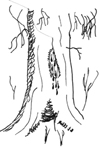Alaska Science Camps, Fairs & Experiments
ANKN is a resource for compiling and exchanging information
related to Alaska Native knowledge systems and ways of knowing. We
are pleased to create and distribute a variety of publications
that assist Native people, government agencies,
educators and the general public in gaining access to the knowledge
base that Alaska Natives have acquired through cumulative experience
over millennia.
TO ORDER THIS PUBLICATION:
Contact the ANKN
offices at 907-474-1902 or email uaf-cxcs@alaska.edu.  Spruce
Gum Spruce
Gum
Modern technology has brought us many
different sealants and adhesives.
Oldtimers had a traditional solution that was free, versatile and
available almost everywhere: spruce gum. Oldtimers used spruce gum to
fix leaky canoes and other watertight containers.
 Preparing Preparing
If we try to apply spruce gum as it comes from the tree, it will
not adhere well, and will soon crack. The secret is to heat a mixture
of spruce gum with the right amount of oil or grease.
- If there isn't enough oil, the mixture will be too
brittle.
- If there is too much oil, the mixture will be too soft.
DIFFERENT MIXTURE
EXPERIMENT
|
Find out the right gum/oil mixture.
- Collect some spruce gum in a small can. Most older trees have
an injury or two that is dripping gum. Many trees on top of
cutbanks have such injuries from collisions by ice during
breakup.
- Sew two pieces of birchbark together.
- Slowly heat the spruce gum in a small can, and carefully apply
it to the seam of the sewn bark. When it cools, test it by bending
and twisting.
- Now try the above with different amounts of oil mixed with the
spruce gum.
What proportion seems to work best?
Experiment with different types of oil: vegetable oil, shortening,
even motor oil. Use animal fats, like seal oil or bear fat if you can
get some. What type of oil works best, or are they all about the
same?
Different Temperature
You just conducted the experiment with the materials at room
temperature. If you were patching a canoe, the gum mixture would be
working at the temperature of the water in the lake or river. Put
some on your fingers and test it in the water (don't burn yourself.)
What differences do you see in the spruce gum mixture at this
temperature?
I have used spruce gum to fix a boat in the past. Test the gum
between your fingers in the river water, making sure the mixture was
pliable at that temperature before applying it to the boat.
 What
is the ratio of gum to oil? What is the temperature of the What
is the ratio of gum to oil? What is the temperature of the  water? water?
Is gum a better adhesive or sealant?
Now, prepare the best mixture from your experiment above. Put
beaver, moose or other fur in the gum mix. Does this increase its
strength?
What conclusions might you draw about spruce gum as a calk or
sealant on a boat? Is there a difference in the types of spruce gum?
Is the clear gum better than the gum that has turned white and hard,
or do they both melt down well in the can?
You might also want to test the gum mixture as a sealant on
different materials: birch bark, wood (dry and damp), aluminum, and
skin (as used for skin boats). What conclusions can you draw from
this?
Compare spruce gum with silicone or other sealants.
Is spruce gum affected by gasoline or other solvents after it is
applied to a seam?
What conclusions can you draw about spruce gum as a sealant
on the
above materials?
Other Applications
Spruce gum is also very effective to stop bleeding and infections
in cuts. Oldtimers put spruce gum in a cut and left it there. Its
medicinal value is high. Try softened gum in a cut the next time a
small accident happens.
People who understand medicinal plants say to get gum from a young
strong tree. A tree that is too small is like and infant, and isn't
healthy enough yet. A tree that is too old is losing its life force.
A tree that is the equivalent of a 20-30 year old person has the most
resistance to bacteria.
Spruce gum is a healthy replacement for chewing gum. However, it
is quite sticky. We sometimes heat it and mix in a little sugar,
letting it cool again. Some gum is very dry on the tree, other gum is
quite pitchy. Experiment to find the best gum for chewing. Don't be
discouraged in the process. There is a certain texture you are
looking for.
 We
chew spruce gum after eating salmon eggs to remove the sticky eggs
and other food particles. Try it. We
chew spruce gum after eating salmon eggs to remove the sticky eggs
and other food particles. Try it.
To remove spruce gum from hands or clothing, rub in some
shortening. When it has removed the gum, wash them both off with soap
and water.
|